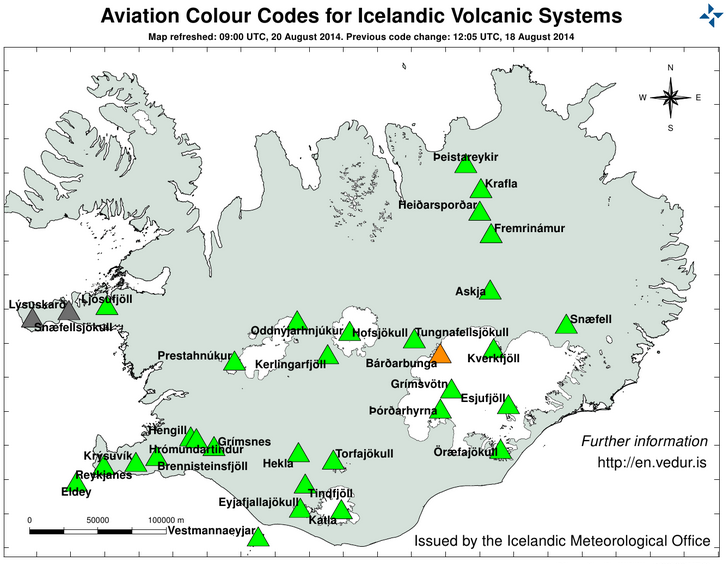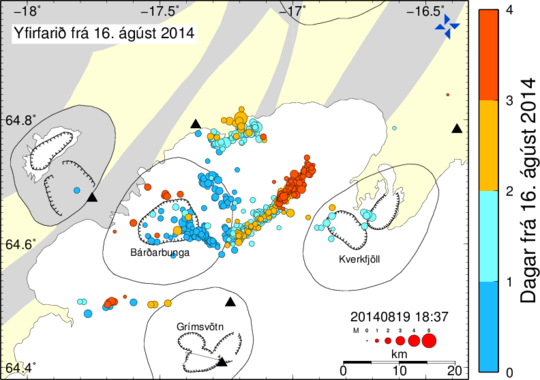/cdn.vox-cdn.com/uploads/chorus_image/image/37218004/187377648.0.0.jpg)
[Update: As of August 23, scientists are still waiting to see if an eruption will occur.]
Back in 2010, Iceland's Eyjafjallajökull volcano erupted, spewing ash for miles into the air and causing widespread chaos. Airlines around Europe shut down for six days, for fear the volcanic ash could harm jet engines. Millions of passengers were left stranded.
And now there's another big volcano in Iceland making ominous noises. Bárðarbunga is part of a volcano system underneath a massive glacier in the center of the country. And, since Saturday, seismologists have detected some 3,000 earthquakes in the region — a sign that magma may be on the move.
So far, there's no sign that the magma is migrating upward — and it's entirely possible the volcano won't erupt at all — but Iceland is currently on high alert.
So does this mean we're in for another air-travel catastrophe? Fortunately, there's reason for optimism here. Some experts have noted that even if Bárðarbunga or a nearby volcano does erupt, we're unlikely to see a repeat of the fiasco in 2010. In part that's because the 2010 eruption was unusually well-calibrated to cause maximum chaos. But airlines have also changed their policies on dealing with ash since then, and fewer planes are likely to stay grounded. (Case in point: A large 2011 eruption in Iceland saw many fewer travel disruptions.)
On the other hand, Bárðarbunga could conceivably cause some damage in Iceland, especially if an eruption melts part of the glacier and causes flooding. Let's take a look:
What is Bárðarbunga? Is it going to erupt?

Aviation color codes for Iceland's volcanoes. Bárðarbunga is in orange, indicating "increased potential for eruption." The rest are in green, indicating a background state. (Icelandic Meteorological Office)
Bárðarbunga is part of a large volcano system lying underneath Iceland's 500-meter thick Vatnajokull glacier in the center of the country. And, yes, there are signs that Bárðarbunga could erupt soon — although nothing's for certain yet.
Map showing the Mid-Atlantic Ridge splitting Iceland and separating the North American and Eurasian Plates. The map also shows Reykjavik, the capital of Iceland, the Thingvellir area, and the locations of some of Iceland's active volcanoes (red triangles), including Krafla (USGS)
Some quick background: Iceland sits right on top of two tectonic plates that are pulling away from each other (see map right). Scientists also believe that there's a giant mantle plume beneath Iceland, bringing up hot rock toward the Earth's surface.
Both of those factors make Iceland an ideal place for a variety of volcanic activity — the island has some 30 active volcanoes in all, and eruptions occur roughly once every three years, on average.
Bárðarbunga, for its part, has been fairly quiet for some time. Geological records suggest that the volcano historically erupts a couple of times per century, with the last one occurring back in 1910. But Bárðarbunga is possibly connected to other volcanoes in the vicinity that have been more active recently — nearby Grímsvötn erupted in 2011.
(By the way, if you're wondering how to pronounce "Bárðarbunga," there's a helpful video guide here — and best of luck to you.)
Now there's a possibility Bárðarbunga could erupt in the near future. On August 16 and August 17, Icelandic scientists detected a pair of earthquake swarms in and around the volcano. Since then, some 3,000 earthquakes have been recorded — a sign that magma is shifting around beneath the surface:

A summary map of all manually revised earthquakes since the onset of the swarm, which illustrates the migration of earthquake activity during the last days. Earthquakes in the map are colour coded by time, dark blue dots show the onset of the swarm on Saturday, orange dots Tuesday's events until 19:00, light blue and yellow are the days in between. The time scale is days since the onset of the swarm. (Icelandic Meteorological Office)
The Icelandic Meteorological Office has declared an "orange" alert for Bárðarbunga— that is, "Volcano shows heightened or escalating unrest with increased potential of eruption." What's more, on August 20, authorities evacuated an uninhabited area around the island.
Still, an eruption's not yet a certainty. The IMO is insisting that they haven't yet seen any sign that magma is moving toward the surface. So far, all the activity has remained 3 to 7 miles underground — that is, the magma still appears to be moving horizontally. The agency is continuing to monitor the situation.
[Update: On August 21, the IMO offered an updated assessment: "There are no measurements to suggest that an eruption is imminent. Previous intrusion events in Iceland have lasted for several days or weeks, often not resulting in an eruption." However, the IMO also noted that it couldn't rule out an eruption just yet. However an eruption of Bárðarbunga cannot presently be excluded, hence the intense monitoring and preparation efforts."]
As Dave McGarvie, a researcher who works on Icelandic volcanoes, explains here, there are couple of ways that things could unfold. One, it's possible that nothing could happen, and the magma will simply remain beneath the surface. Alternatively, perhaps there will be a minor eruption that doesn't penetrate the glacier — that would cause lots of flooding, but it might not spew much ash in the air.
Finally, McGarvie notes, we could see a really big eruption that breaks through the ice. A lot depends on where, exactly, the eruption occurs, what form it takes, and how thick the ice above the eruption is.
Could a volcanic eruption disrupt air travel?
/cdn.vox-cdn.com/uploads/chorus_asset/file/664478/4635727483_a82c766410_b.0.jpg)
Icelandair 757-200 TF-FIU (BriYYZ/Flickr)
Even if Bárðarbunga does erupt, some experts argue that it likely wouldn't be quite as disruptive as Eyjafjallajökull was back in 2010.
That 2010 eruption, recall, forced airlines in Europe to close for six days, grounded more than 100,000 flights, stranded millions of passengers, and cost the industry some $200 million.
But that doesn't mean we should expect a repeat. As McGarvie explains here, the 2010 eruption was something of a "perfect volcanic storm" — the winds happened to carry the ash from the volcano right over mainland Europe. That eruption was also unusually long-lived and had a disproportionately high amount of fine ash that can travel long distances.
But more importantly, airlines at the time had an "avoid all ash" policy that forced them to steer clear of all eruptions, as John A. Stevenson, a researcher studying volcanoes at Edinburgh University, explains here. Airlines figured that any ash was harmful to jet engines and planes should just steer clear. That proved impractical in the case of Eyjafjallajökull, since ash was everywhere in the North Atlantic, and many airlines just shut down.
After the eruption, airlines relaxed those policies significantly. Planes can now fly in areas with 4,000 micrograms of ash per cubic meter. That means an eruption will ground fewer planes. This policy got put to the test in 2011, when Iceland's Grímsvötn volcano erupted. That actually ended up putting more ash into the air than Eyjafjallajökull in a shorter amount of time — it was one of the biggest explosions in a century. But only 900 flights got cancelled. That's a hassle, but not a catastrophe.
A separate, pressing concern is the prospect of flooding in Iceland itself — particularly if the volcano ends up melting significant chunks of the Vatnajokull glacier. Officials are already warning about the possibilities of floods in the northeast of the country, should an eruption occur.
Further reading: There are excellent scientific rundowns of Bárðarbunga from Alexandra Witze at Nature News and Eric Holthaus at Slate.